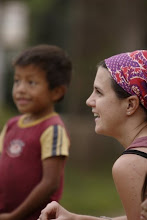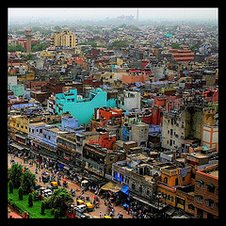
Friday 24 August 2007
Thanks

Tuesday 21 August 2007
Unintended Consequences of a Call Center
Thanks to the terrible traffic in Mumbai, I spent a lot of time with Iqbal, the driver for my friend. Originally from Pune, Iqbal is a Muslim who was born and raised in
Iqbal told me all about the Muslim community in Mumbai. He was incredibly open and we discussed veils and women’s rights as well as fundamentalism and terrorism. Proud of his religion but concerned about the extremists, Ikbal represented the modern Muslim Indian.
Still, I was most amazed with the story of Iqbal’s son, who works in a call center nearby. Though Iqbal has struggled financially throughout his life, he is comforted by the fact that his son has many more opportunities. His son speaks English fluently and has secured a high-paying position. Ikbal says that this job has changed his son’s life; he is committed to working hard to achieve success and is hopeful for the future. In addition, he has a Christian girlfriend whom he met at work. When I asked Iqbal if he was okay with his son’s girlfriend, he said that things had been different for his generation but his son helped him realize that they were happy. Which made Iqbal happy.
Of course, Iqbal and I both know that the call center job itself does not create this happiness in and of itself. Still, these jobs can have a positive impact on employees. They are paid well relative to the national average, receive excellent training and are likely to move up within their organizations if they work hard. They are also exposed to the broader world and are more invested in the future. In addition, young folks like Iqbal’s son are less likely to be influenced by extremism than disenfranchised Muslim youth who live in crowded, under-resourced slum communities where the offer of fundamentalism seems more enticing.
I am not naïve enough to believe that call centers can save the world. Still, Iqbal’s son provides a compelling portrait of the upside of globalization. Please remember him the next time you get frustrated with customer service. Don’t be mean to the representative, just insist on speaking to a supervisor!
Saturday 18 August 2007
Maximum City
Through a connection from a Stanford classmate, I visited a school for disabled children and community programs in the slums. Once again, I realized how doubly difficult it is to be poor and disabled, physically or emotionally. Still, I was impressed by the competence and compassion of the school’s staff who insist that these children are treated with dignity and, ultimately, empowered to live a normal life.
I also met with a group of mothers from the slums. These women are part of a self-sustaining help group. With sewing machines, they produce goods such as tablecloths and handcrafts. As they work, they discuss the challenges they face as well as support each other.
I introduced myself to the group and explained my background. When I mentioned my work combating domestic violence, one woman raised her hand. She was a composed woman in her early twenties who was 7 months pregnant. She explained that her husband had died six months ago. He was killed by a train on the tracks near the slums. She was unsure whether it was an accident or murder. Such a death is not uncommon among Mumbai’s poor; accidents occur because tracks are often crossed or used as bathrooms. More tragically, the tracks are sometimes used as killing grounds (railroad deaths are difficult for the police to track, if they are interested in investigating at all).
On top of grieving, this woman had to deal with an abusive family. In accordance with tradition, she had moved in with her husband’s family after she got married. Since her husband’s death, her in-laws had been harassing her because they wanted to claim the small amount of compensation that the railroads provide for anyone who dies on the tracks. She was afraid for her life, especially after she gave birth. Her greatest fear was that she would have a male child and her in-laws would take the boy and kill her. With a male heir, there was no need for her.
As the group discussed her alternatives, I realized how few options this woman had. She desparately needed the compensation money but she also had to escape. She cannot go home as her family will not accept her. And there are no shelters. She could call the police but they are unlikely to respond. Instead, she will have to work with the group to establish an informal method of protection where she will rely on friends and neighbors to intervene if the abuse escalates. And she will just hope for a girl.
I felt incredibly humbled and saddened. I also learned that there is an entire informal system that operates in lieu of the formal structures in the slums. From basic services to courts and childcare, these slum communities function in parallel to the official world. Government-issued property deeds may not exist but there is a network of slum landlords who “own” all the property and collect rent every month. There are informal police (thugs) who ensure “safety and security” for a certain price. The moneylenders and merchants offer products, most of which are as expensive (or more) as those you find outside of the slums. Yet again, location is everything. In fact, some research indicates that it may be costlier in relative terms to live in the slums. People spend more of their incomes on basic services and goods because they have such limited options.
[Post-script: I will email the community program staff to find out what has happened with the woman I met and will update the blog if I find out more.]
Friday 10 August 2007
Mom-trepreneur

How do you translate “work-life balance” into Hindi?
In my field visits, I met with several woman entrepreneurs who were also moms. I was especially impressed by the women who were running a thriving computer education business and handling little ones at home. And remember too, that the workweek here is Monday-Saturday.
When I asked how they manage it all, most smiled graciously and acted as though it was no problem. Probing deeper, I have figured out certain keys to their success:
The Home Office
Most of these moms run kiosks that are adjacent to their homes. They can move easily between the office and the home, enabling them to bounce back and forth between checking accounts, chopping vegetables and changing diapers. Not only does this reduce the barriers for women to become entrepreneurs but they tend to run more stable businesses because they are less likely to move or change jobs. The switching costs are just too high.

Childcare
As I have experienced in my homestays, it is all in the family. Or, at least, all of the family is in one place. Most homes include extended families, with parents, grandparents, aunts and uncles. It is based around the patriarchal unit; women typically move in with their husband’s extended family after marriage. Though it can be hectic at times, all those grandparents, uncles and aunts means that there is always someone to watch over the little ones. What is especially cool is that the kids have closer relationships with their extended relatives.
Role of Operating Partner
With woman entrepreneurs, especially those with limited experience, Drishtee often works closely with the primary male figure in her life. We call the husband, father or brother the “operating partner” and we truly seek to treat the two as partners. We want to build on the strengths and experiences of the operating partners while empowering the woman entrepreneurs to develop their own skills.
This practice also helps us get more buy-in in rural India where individuals are less likely to support a woman working on her own. Though I have had my own reservations about power imbalances between partners, this system seems to work well, in part because it uses the family unit as the foundation for the business.
It may not work everywhere but the mom-trepreneur model provides for a great balance between work and family life in rural India.

Wednesday 8 August 2007
Laughing Yoga, Seriously

How many times have you laughed today? Yesterday? If you are like most adults, you probably are not laughing as much as you should. When we are little kids, we can’t stop laughing. But then we grow up and get serious.
It turns out that we should get serious about laughing. I spent Sunday night at a 10th anniversary celebration dinner for my community’s Laughing Club. That’s right, 10 years of laughs, chuckles and guffaws, all without the aid of jokes!

My landlord, Uncle, with an honorary hat
I was invited by my landlord and neighbor, a fabulous fellow whom I know as Uncle. Even though they are retired and could sleep as late as they wanted, he and his wife are up at 5:15 every morning for their walk and yoga. After a stroll in the park, they meet and practice their laughing.
In addition to songs, dances and presentations on the health benefits of laughing, I watching this synchronized laughing in action at the celebration dinner. Imagine a stage full of people, most of whom are older, wearing colorful hats. All is silent. Then a whistle blows and the group erupts in coordinated hee-hee-hee’s or hah-hah-haw’s. It was unlike anything I ever seen. And it was contagious. My friends and I were laughing so hard we were in tears.
I cannot vouch for the medical benefits of laughing. But I do know that it was really fun.

Ann, Auntie, Josh and two other Laughing Club ladies
Monday 6 August 2007
The Gift of School

The best gift I have ever received in my life is education. Which makes me so sad when I see so many kids who are being denied this here. Like this little guy.
With education, it is a Tale of Two Indias. It has the best of schools, it has the worst of schools. Some of the finest engineering, computer programming and business schools are here. Literacy rates in certain areas are unbelievably high, especially when compared to per-capita income. At the same time, there are many rural and slum children who are not in school. At the government schools, the facilities and resources are deplorable. And the teachers, well, they don’t even show up for school that often.
In spite of this, Indians are fiercely interested in education. There is an amazing array of educational opportunities from private schools to supplemental classes to tutoring programs. The newspapers are chock full of education advertisements. And people are willing to spend a significant portion of their earnings on education, rather than on material goods.
This is especially true if the education pertains to technology. Technology has helped spur India's phenomenal growth recently and everyone wants a piece of the action. Computers and cell phones are spreading to the most remote parts and now everyone wants to learn how to use them.

Sunday 5 August 2007
Dads and Daughters
It turns out that some dads in India feel the same way about their daughters. A few of the amazing students I met last week were the daughters of rural farmers. Even though their fathers have never even used computers, they convinced them to spend at least a month’s earnings on tuition for a computer education class. They helped their dads understand that learning computer skills would be critical for their future. Pretty impressive.

These acts of persuasion are an especially remarkable in India where investments in girls’ education are often perceived to be a waste. Most women will get married and move to their husband’s village so the family never fully captures the value of their daughter’s education.

These girls were all so shy when I met them. After finishing my questions, I always encouraged them to ask questions of me. Most were too intimidated to say anything. Little did they know that I was as awe-inspired by their courage and will to learn as they were with me.

Saturday 4 August 2007
A Forgotten Passport, A New Family
I stayed with Amit and his extended family at their home. They were not expecting me but they were the most generous hosts. In fact, I became a part of the family. Not only did they provide a bed but Amit’s mother fed me delicious food and endless cups of ginger chai. Amit’s uncle, Babaji, let me watch as he completed his Hindu worship ceremonies, complete with drums and bells, each morning. I chatted with Amit’s father and hung out with Amit’s wife and cousins. And Amit’s beautiful daughter kept me smiling throughout it all.
The best time was Friday night when we all sat around in the living room, looking at pictures, talking about life, families, India and America. At some random point, I looked around the room and realized why I do the work I do: I believe in people. Just when everything feels impossible, I meet people who are so good that they give me hope for our entire society.
A special thanks to Ajay, Rajiv, Amit and his family for taking care of me.

Friday 3 August 2007
Business in the Boondocks
As I have learned this summer, the rural sector presents a complex set of challenges for business. From management and organizational structure to marketing and operations, you have to do things differently. You cannot just rely on size and speed. There is nothing speedy about spending two hours on the back of a scooter, traveling less than 20 kilometers, just to get to the office. Especially in monsoon season. Check out the main road to town here:

You cannot just hire a bunch of a great people and throw them together on a project. Having spent 27 hours on a train, I now understand why company retreats do not occur here. And, as demonstrated by this picture of the electricity “infrastructure” at one of our kiosks, there is a total lack of basic resources:

So you have to be innovative and resourceful. You have to overcome geographical obstacles, limited resources, lack of human capital and lack of experience. And you have to be credible. In most villages, there is usually a history of exploitation that leads itself to mistrust of businesses.
That said, if you can do it, you can have a big impact, both in terms of profit and development. So, where do you start? You begin with the same premise that design theory, social work and business all share: know your customers or clients and meet them where they are at. If you do not understand the daily life of the rural Indian, you cannot sell to him, support him or empower him.
Drishtee understands this. Management consistently emphasizes that the magic happens in the field. At the top, we need to create a self-sustaining structure that, with the right mix of people, products and support, can run itself. The structure has to be sound enough to enable success for less-qualified (but hard-working) individuals while being flexible enough to allow the high-performers to soar. Sounds simple, right?
Of course, it is not. But we are trying, along with a few other intrepid organizations. In fact, India is ahead of the curve when it comes to rural marketing and business. There is an entire business school dedicated to this field. However, someone told me that the students cannot afford to work in rural areas after they graduate because of the debts they have to pay off! Add yet another obstacle to the list.













